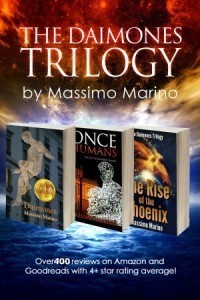Just Show, Don’t Tell and Show
 New and not-so-new writers often fall in the trap of depriving their readers the subconscious pleasure of discovering the story by telling too much. When we tell, we limit our readers.
New and not-so-new writers often fall in the trap of depriving their readers the subconscious pleasure of discovering the story by telling too much. When we tell, we limit our readers.
Telling is the lazy way out, but when we show our readers, we engage their senses and mind; we pull them into our words.
Writers sometimes make the mistake of telling — then go on to show what they just told their readers.
She was angry. She threw the glass at him. His shirt was stained red from the wine.
“I paid $85 for that bottle of wine,” he said.
Of course, people don’t throw glasses of very expensive (or inexpensive) wine at someone if they aren’t angry. This combination of telling and showing, though, can make a reader feel patronized. Cut the words.
She threw the glass at him, staining his shirt red.
“I paid $85 for that bottle of wine,” he said.
A good way to test ourselves is to reread what we’ve written to see what facts we give and then rewrite to show only those facts.
Showing involves details, description, dialogue, sounds, smells, sensations. Let your readers experience them. Let’s see some examples.
Told: The Richards were poor, and paying bills amounted to heartbreaking moments of difficult choices and painful compromises.
Shown: No matter how Bill Richards tried to stretch the family budget he couldn’t. He looked at the piles of paper stacked on the kitchen table. Should he pay half the rent or half the heating bill? Or all the rent, and nothing to the oil company? No, last winter, when he did that, they refused to deliver oil and his family huddled in blankets until their next payday. Just lucky the pipes hadn’t frozen. Now the first snow is due. He couldn’t risk that again.
The difference: For poor Bill Richards, how poor is poor? Some people might feel poor if they can’t go on holiday. For others it means not eating. For a family in Nigeria, Bill’s poverty represents great wealth. Notice how the second example never uses the word poor, but we have no doubt that the Richards family struggles.
That is because the details show how he needs/wants to stretch his budget, that he doesn’t have enough to cover everything, and that he has had to make choices. We get an idea of the level his poverty. We know he doesn’t own his own house but rents. We know that his money troubles have been going on for at least a year, because he had problems last winter. We also know that winter is coming again, although we haven’t been told it directly. The first snow is the detail that lets us in on tyranny of the calendar. We also can imagine/feel how cold the family was without heat.
Told: It was a warm day of spring.
Shown: Violets peppered the hill side. The sun no longer set before dinner but stayed around a bit later. Children ran with their coats opened, calling to each other. Baseballs replaced hockey pucks. There was the smell of damp earth.
The difference: We each have our own idea of spring, tulips come up, the snow melts. However in the told example all we have is the fact that it was spring. However the second example engages our senses: Violet is a color for our sight. There is the special smell of spring dirt. We hear the voices of children, but we are also aware that it is only warm enough to unzip their jackets, not warm enough to take them off.
Told: She didn’t believe him, she knew he was lying.
Shown: “You’ve got to be kidding.” She shook her head. “You must think I am stupid to fall for that.”
This is a good example of dialog showing us what the character is thinking. It also shows her as a person not willing to be fooled and willing to challenge the man by accusing him of thinking her stupid.
Massimo Marino is a scientist envisioning science fiction. He spent years at CERN and The Lawrence Berkeley Lab followed by lead positions with Apple, Inc. and the World Economic Forum. He is also co-founder of “Squares on Blue”, a Big Data Analytics service company.
Massimo currently lives in France and crosses the border with Switzerland multiple times daily, although he is no smuggler.
As a scientist writing science fiction, he went from smashing particles at accelerators at SLAC and CERN to smashing words on a computer screen.
He’s the author of multi-awarded Daimones Trilogy.
His novels have received the Seal of Excellency from both AwesomeIndies.net and IndiePENdents.org
• 2012 PRG Reviewer’s Choice Award Winner in Science Fiction
• 2013 Hall of Fame – Best in Science Fiction, Quality Reads UK Book Club
• 2013 PRG Reviewer’s Choice Award Winner in Science Fiction Series
• 2014 Finalist – Science Fiction – Indie Excellence Awards L.A.
• 2014 Award Winner – Science Fiction Honorable Mention – Readers’ Favorite Annual Awards
His novels are available from Amazon, Barnes & Noble (Nook), iTunes Apple Store, and many other retailers around the world.
Join his mailing list for new releases, or follow him on Facebook, Google+, and Twitter.
The post Just Show, Don’t Tell and Show appeared first on § Author Massimo Marino.




